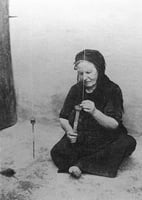In this episode, we take a deep dive into the fascinating history of gold thread-making in Fez,...
The Golden Thread of Fez: A Journey Through Time and Craftsmanship
The art of gold thread manufacturing, or sqalli, in Fez stands as a testament to the city's rich cultural tapestry and intricate craftsmanship. Historically, this craft has been predominantly managed by the Jewish community in Fez, showcasing a unique blend of industrial and commercial prowess distinct from the practices of their Muslim counterparts.
The Unique Structure of the Gold Thread Craft
In contrast to other trades where production and commerce are segregated into distinct guilds, the gold thread industry in Fez combines both aspects within a single corporate structure. This amalgamation means that even those primarily engaged in the commercial side of the business are referred to as ma’allemin sqalli, a title that traditionally signifies a master craftsman. This blend has resulted in a complex and less specialized organization compared to the more compartmentalized Muslim crafts.
Evolution and Industrialization
As the craft evolved with modern influences, it underwent significant industrialization, a transformation that provides valuable insights into the inevitable evolution of such trades. By the late 1920s, the industry supported numerous families in the Mellah, the Jewish quarter of Fez, underscoring its vital economic role.
Historical Significance and Craft Techniques
Gold thread production, known as tesqallit, has long been esteemed in Fez, offering a lucrative livelihood for many. This craft involves several distinct processes, from gold beating to thread spinning, each requiring specialized skills. The gold and silver used in production were often sourced locally through auctions or brought by individuals in need of cash, while silk was procured from the Medina's merchants.

The Ma’allemin Sqalli
Around 1920, about twenty ma’allemin sqalli, mostly from four prominent families (Cohen, Danan, Wahnis, and Mimrane), dominated the trade. These individuals not only mastered the technical aspects of the craft but also managed the business side, purchasing raw materials and overseeing the production process. Their operations required substantial capital, reflecting the lucrative nature of the business and their significant status within the community.
The Dar Sekka Operations
The Dar Sekka, or the House of Coin, played a crucial role in verifying the purity of metals used in the craft. This meticulous process involved various steps, from melting and refining metals to the intricate work of laminating and drawing threads. The equipment and techniques used, such as the ancient wooden drawing benches, reflect the deep-rooted traditions and skillful craftsmanship of Fez's artisans.
Economic and Social Impact
By the end of the 1920s, the gold thread industry in Fez employed around 550 people, a substantial figure given the quarter's population of approximately ten thousand. This industry's complexity and its integration into the social and economic fabric of the Mellah highlight its importance.
The gold thread craft of Fez is more than just a trade; it is a symbol of cultural heritage and economic resilience. As modern influences continue to shape traditional practices, preserving such crafts remains crucial. The legacy of the ma’allemin sqalli and their intricate art is a testament to the enduring spirit of Fez, a city where history and craftsmanship intertwine in golden threads.



